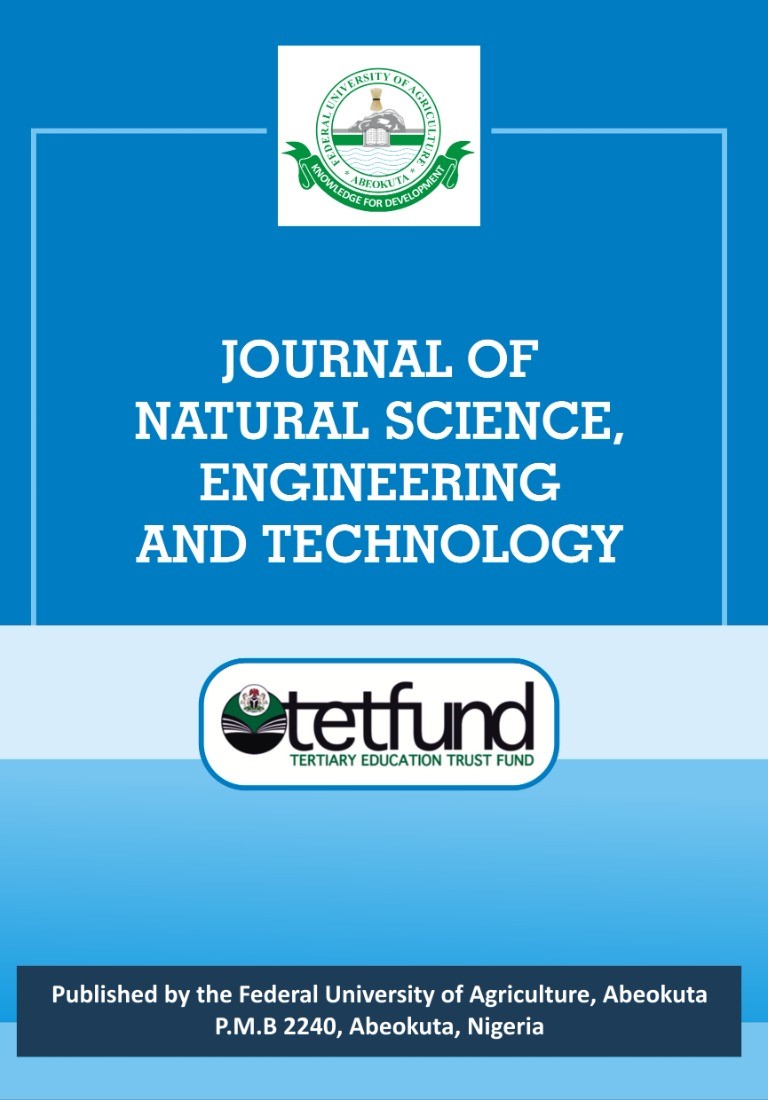IN SILICO IDENTIFICATION OF BIOACTIVE COMPOUNDS FROM MEDICINAL PLANTS AS POTENTIAL GLUCOKINASE INHIBITORS FOR DIABETES MANAGEMENT
Keywords:
Diabetes, Target-protein, Glucokinase, In silico studies, Molecular docking, PhytochemicalsAbstract
Diabetes, a chronic elevation in blood glucose levels, is primarily caused by the inactivation of glucoki-
nase, a glucose sensor enzyme present in insulin-secreting pancreatic beta cells. This study investi-
gated the inhibitory potential and proposed competitive binding mechanism of bioactive compounds
from six medicinal plants: (Mormordica charantia L., Aloe barbadensis Mill., Cinnamomum zeylanicum
L., Vernonia amygdalina H., Persea americana M., and Trigonella foenum-graecum L.) against Gluco-
kinase active sites. Thirty (30) bioactive compounds were selected and screened together with Pi-
ragliatin (control drug). The PubChem identification number, 3D structure, and canonical SMILES of
the phytocompounds and control drug were obtained using the PubChem online server. Drug likeness
screening and other molecular docking analyses were carried out using web-based tools
(SwissADME, AutoDock Vina, and Molinspiration). The absorption, distribution, metabolism, excretion
(ADMET), and toxicity profiles of the ligands were evaluated using ADMETlab online tool. The drug-
likeness screening showed that 23 of 30 bioactive compounds violated one or more of the four rules
(Lipinski, Ghose, Veber, and Egan). The protein-ligand docking revealed that anthraquinone, cin-
namaldehyde, coumarin, beta-amyrin, diosgenin, lutein, zeaxanthin, beta-carotene, and silymarin had
higher binding energies of -8.8 kcal/mol, -7.6 kcal/mol, -8.1 kcal/mol, -7.8 kcal/mol, -8.6 kcal/mol, -7.8
kcal/mol, -7.8 kcal/mol, -8.5 kcal/mol, -7.5 kcal/mol, respectively compared with that of Piragliatin (-7.0
kcal/mol). Compounds with higher binding affinity violated at least one rule except for the non-
carcinogenic anthraquinone with no drug-likeness screening violation. This study revealed anthraqui-
none and other lead bioactive compounds as potential antidiabetic drugs for further consideration and
wet lab experimentation.
References
Adegbite, A.E. 2008. Leaf anatomical studies in some species of the tribe Cichorieae (Asteraceae) in Nigeria. Comparative Newsletter, 46: 49-58.
Ayodele A.E. and Olowokudejo J.D. 2006. The family Polygonaceae in West Africa. Taxonomic significance of lead epidermal character. South African Journal of Botany, 3: 442- 459.
El-Fiki, M.A.; El-Taher, A.M.; EL-Gendy, A.G. and Lila, M.I. 2019. Morphological and anatomical studies on some taxa of family Apocynaceae. Al-Azhar Journal of Agricultural Research, 44, 136–147.
Endress M.E. and Bruyns P.V. 2000. "A revised classification of the Apocynaceaes.l."(PDF). The Botanical Review, 66:1-56.
Fabeku, P.O. 2006. Traditional Medicine: The Arts, Ways and Practice. In Outlines and Pictures of Medicinal Plants from Nigeria, 1st edition; Tolu Odugbemi (editor); University of Lagos press: Lagos, Nigeria, Pp. 117–125.
Fayose, O.H. and Freke, R.M. 2016. A study on the Floral and Epidermal characteristics of two species of Ixora. International Journal of Medicinal Plant Research, 5:299–306.
Haruna, H. and Ashir, H.I. 2017. Leaf Epidermal Structures and Stomata Ontogeny in some members of the Lamiaceae Family. Bayero Journal of Pure and Applied Sciences, 10: 670–675.
Ibrahim, J.A.; Ayodele, A.E.; Jegede, A.I. and Kunle, Y.F. 2006. Comparative Studies on Khaya A. Juss. (Meliaceae) in Nigeria. African Journal of Biotechnology, 5:1154–1160.
Ibrahim, J.A.; Ayodele, A.E.; Okhale, S.E.; Jegede, A.I. and Kunle, O.F. 2009. The taxonomic significance of Agelanthus dodoneifolius (DC.) Polh. & Wiens in relation to its hosts. Nigerian Journal of Botany, 22: 89–101.
Ibrahim, J.A. and Ayodele, A.E. 2013. Taxonomic Significance of Leaf Epidermal Characters of the Family Loranthaceae in Nigeria. World Applied Sciences Journal, 24:1172–1179.
Kannabiran, B. and Ramassamy, V. 1988. Foliar epidermis and taxonomy in Apocynaceae. Proceedings of the Indian Academy of Sciences, 98: 409–417.
Li P.T., Leeuwenberg A.J.M. and Middleton D.J. 1995. Apocynaceae. Flora of China, 16:143−888.
Mbagwu, F.N. and Nwachukwu, C.U. 2008. Comparative Leaf Epidermal Studies on S. macrocarpon and S. nigrum. Research Journal of Botany, 3: 45-48.
Metcalfe, C. R. 1960. Anatomy of Monocotyledons. I. Gramineae. Clarendon Press, Oxford.
Metcalfe, C. R. 1989. Current Development in Systematic Plant Anatomy. In: V. H. Clarendon Press, Oxford.
Ng, F.S.P. 2006. Tropical Horticulture and Gardening. Kuala Lumpur, Malaysia: Clearwater Publications.
Ogunkunle, A.T.J. 2013. The Value of Leaf Epidermal Characters in Diagnosing Some Nigerian Species of Ficus L. (Moraceae). Research Journal of Botany, 8: 1–14.
Olowokudejo, J.D. (1990). Taxonomic value of petiole anatomy of genus Biscutella L. (Cruciferae). Phytomorphology, 40(3-4): 407-422.
Olowokudejo, J.D. and Nyananyo, B.L. 1990. Epidermal morphology of the genus Khaya (Meliaceae) in West Africa. Feddes Repertorium, 101: 401–407.
Omino, E.A. 1996. Contribution to the Leaf Anatomy and Taxonomy of Apocynaceae in Africa: The Leaf Anatomy of Apocynaceae in East Africa: A Monograph of Pleiocarpinae (Series of Revisions of Apocynaceae XLI). Ph.D. Thesis, Landbouw University, Wageningen, The Netherlands.
Oyedapo, O.A., Agbedahunsi, J.M., Illoh, H.C. and Akinloye, A.J. 2018. Comparative foliar anatomy of three Khaya species (Meliaceae) used in Nigeria as ant sickling agent. Science of the Cold Arid Regions, 10:279–285.
Schmidt D.F.N., Yunes R.A., Schaab E.H., Malheiros A., Filho V.C. and Franchi G.C. 2006. Evaluation of the anti-proliferative effect of the extracts of Allamanda blanchetti and A. schottii on the growth of leukemic and endothelial cells. Journal of Pharmacy and Pharmaceutical Science, 9(2): 200-208.
Shokefun, E.O., Ayodele, A.E. and Orijemie, E.A. 2017. A preliminary leaf epidermal and pollen morphology of some West African species of Desplatsia Bocq. Journal of Medical Plant for Economic Development, 1(1), a4, DOI: https://doi.org/10.4102/jomped.v1i1.4.
Wiart, C. 2006. Medicinal Plants of Asia and the Pacific. Boca Raton: CRC Press/Taylor and Francis, Pages 336,https://doi.org/10.1201/9781420006803.
Wong S.K., Lim Y.Y., Abdullah N.R. and Nordin F.J. 2011. Antiproliferative and phytochemical analyses of leaf extracts of ten Apocynaceae species. Pharmacognosy Research, 3:100−106.

